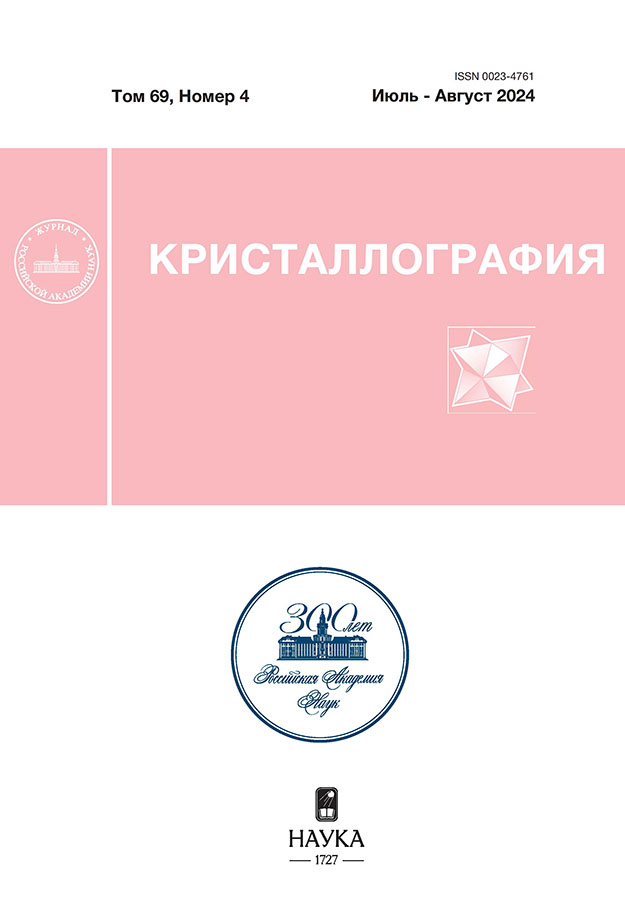Structure of inorganic compounds halogen bonds in derivatives of 2,5-diiod-1,4-dimethylbenzene
- Авторлар: Rajakumar K.1, Zherebtsov D.A.1, Nayfert S.А.1, Osipov A.А.1, Adonin S.A.1,2, Spiridonova D.V.3
-
Мекемелер:
- South Ural State University
- A. E. Favorsky Irkutsk Institute of Chemistry SB RAS
- St. Petersburg State University
- Шығарылым: Том 69, № 4 (2024)
- Беттер: 612-619
- Бөлім: STRUCTURE OF ORGANIC COMPOUNDS
- URL: https://cardiosomatics.ru/0023-4761/article/view/673149
- DOI: https://doi.org/10.31857/S0023476124040062
- EDN: https://elibrary.ru/XDHKLT
- ID: 673149
Дәйексөз келтіру
Аннотация
The synthesis of 1,4-di(bromomethyl)-2,5-diiodo-benzene (1), diacetate of 2,5-diiodo–1,4-di(hydroxymethyl)benzene (2) and diiodide of 1,1’-[(2,5-diiodo-1,4-phenylene)bis(methylene)]dipyridinium (3) is described and their crystallographic data are given. All three crystal structures are characterized by the stacked packing of planar molecules and the presence of halogen bonds I–Br, I–O, and I–I, respectively. The number of halogen bonds is maximum in compound 1: two I–Br bonds for each halogen atom. Compounds 2 and 3 contain one halogen bond per halogen atom, but they are significantly shorter than in compound 1. All crystals were investigated by IR spectroscopy and synchronized thermal analysis. Compound 1, which has no ionic or hydrogen bonds, melts at a higher temperature than ionic compound 3 (218 and 200°C, respectively) due to the presence of a large number of intermolecular halogen bonds. Compound 2 melts at a lower temperature (151°C), which is characteristic of esters.
Толық мәтін
Авторлар туралы
K. Rajakumar
South Ural State University
Email: zherebtcovda@susu.ru
Ресей, Chelyabinsk
D. Zherebtsov
South Ural State University
Хат алмасуға жауапты Автор.
Email: zherebtcovda@susu.ru
Ресей, Chelyabinsk
S. Nayfert
South Ural State University
Email: zherebtcovda@susu.ru
Ресей, Chelyabinsk
A. Osipov
South Ural State University
Email: aaosipov@susu.ru
Ресей, Chelyabinsk
S. Adonin
South Ural State University; A. E. Favorsky Irkutsk Institute of Chemistry SB RAS
Email: zherebtcovda@susu.ru
Ресей, Chelyabinsk; Irkutsk
D. Spiridonova
St. Petersburg State University
Email: zherebtcovda@susu.ru
Научный парк
Ресей, St. PetersburgӘдебиет тізімі
- Cavallo G., Metrangolo P., Milani R. et al. // Chem. Rev. 2016. V. 116. P. 2478. https://doi.org/10.1021/acs.chemrev.5b00484
- Mikherdov A.S., Novikov A.S., Boyarskiy V.P et al. // Nature Commun. 2020. V. 11. 2921. https://doi.org/10.1038/s41467-020-16748-x
- Matveychuk Y.V., Ilkaeva M.V., Vershinina E.A. et al. // J. Mol. Struct. 2016. V. 1119. P. 227. https://doi.org/10.31857/S0044457X21100202
- Yushina I., Tarasova N., Kim D. et al. // Crystals. 2019. V. 9. P. 506. https://doi.org/10.3390/cryst9100506
- Albright E., Cann J., Decken A. et al. // Cryst. Eng. Commun. 2017. V. 19. P. 1024. https://doi.org/10.1039/C6CE02339H
- Baykov S.V., Filimonov S.I., Rozhkov A.V. et al. // Cryst. Growth Des. 2020. V. 20. P. 995.
- Albietz P.J., Cleary B.P., Paw W. et al. // J. Am. Chem. Soc. 2001. V. 123. P. 12091. https://doi.org/10.1021/ja016127l
- Albietz P.J., Cleary B.P., Paw W. et al. // Inorg. Chem. 2002. V. 41. P. 2095. https://doi.org/10.1021/ic025506s
- Rajakumar K., Sharutin V.V., Adonin S.A. et al. // J. Struct. Chem. 2022. V. 63. P. 620. https://doi.org/10.1134/S0022476622040138
- Grunder S., Huber R., Horhoiu V. et al. // J. Org. Chem. 2007. V. 72. P. 8337. https://doi.org/10.1021/jo7013998
- Gaefke G., Enkelmann V., Höger S. // Synthesis. 2006. V. 17. P. 2971. https://doi.org/10.1055/s-2006-942534
- Costa A.L., Ferreira L.F., Prata J.V. // J. Polym. Sci. A. Polym. Chem. 2008. V. 46. P. 6477. https://doi.org/10.1002/pola.22957
- Hodecker M., Kozhemyakin Y., Weigold S. et al. // Chem. Eur. J. 2020. V. 26. P. 16990. https://doi.org/10.1002/chem.202002552.
- Jordan R.S., Wang Y., McCurdy R.D. et al. // Chem. 2016. V. 1. P. 78. https://doi.org/10.1016/j.chempr.2016.06.010
- Fan Q.-L., Lu S., Lai Y.-H. et al. // Macromolecules. 2003. V. 36. P. 6976. https://doi.org/10.1021/ma030093f
- Nishinaga S., Sawanaka Y., Toyama R. et al. // Chem. Lett. 2018. V. 47. P. 1409. https://doi.org/10.1246/cl.180644
- Horváth D.V., Holczbauer T., Bereczki L. et al. // CrystEngComm. 2018. V. 13. https://doi.org/10.1039/c8ce00041g
- CrysAlisPro 1.171.41.103a (Rigaku Oxford Diffraction, 2021).
- Dolomanov O.V., Bourhis L.J., Gildea R.J. et al. // J. Appl. Cryst. 2009. V. 42. P. 339. https://doi.org/10.1107/S0021889808042726
- Sheldrick G.M. // Acta Cryst. A. 2015. V. 71. P. 3. https://doi.org/10.1107/S2053273314026370
- Sheldrick G.M. // Acta Cryst. C. 2015. V. 71. P. 3. https://doi.org/10.1107/S2053229614024218
- Mantina M., Chamberlin A.C., Valero R. et al. // J. Phys. Chem. A. 2009. V. 113. P. 5806. https://doi.org/10.1021/jp8111556
Қосымша файлдар














